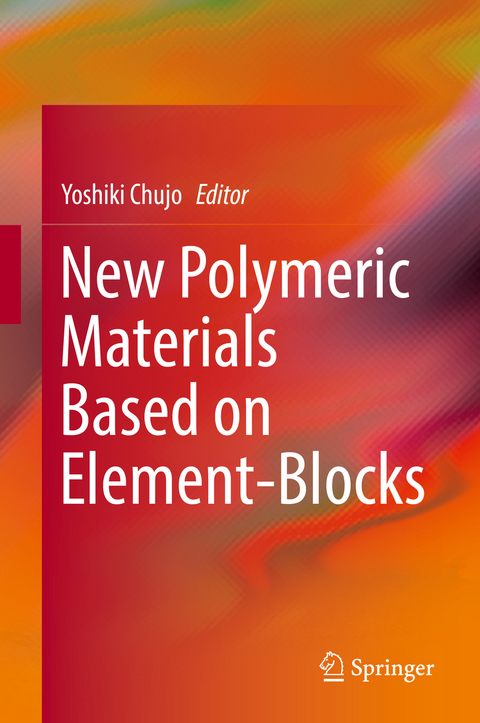
New Polymeric Materials Based on Element-Blocks
Springer Verlag, Singapore
978-981-13-2888-6 (ISBN)
Prof. Yoshiki Chujo Professor Emeritus, Kyoto University, Japan Yoshiki Chujo completed his Ph.D. at Kyoto University in 1980 and then joined Nagoya University as an Assistant Professor in 1981. In 1986, he returned to Kyoto University as a Lecturer, and was promoted as a Professor of Polymer Chemistry there since 1994. His research interests focus on polymer synthesis, inorganic polymers, and polymeric hybrid materials. Prof. Chujo has been working as a Project Leader of the MEXT Scientific Research on Innovative Areas “New Polymeric Materials Based on Element-Blocks”, Japan during 2012-2017. He has retired from Kyoto University in 2018, and now is a Professor Emeritus of Kyoto University, together with a Guest Professor of Ritsumeikan University, and a Commission Professor of Doshisha University, Japan.
1.Element-Block Materials: New Concept for Development of Advanced Hybrids and Inorganic Polymers - 2.Si-, Ge-, and Sn-Bridged Biaryls as π-Conjugated Element Blocks - 3.Elements-block π-Conjugated Polymers by Post-element-transformation Technique - 4.Borylated Polystyrenes as Versatile Functional Materials - 5.Element-block polymeric materials based on cage silsesquioxane frameworks - 6.Silsesquioxane based hierarchical and hybrid materials - 7.Nanocomposite materials properties of aminophenylsilsesquioxanes - 8.Necklace-shaped Dimethylsiloxane Polymers Bearing Polyhedral Oligomeric Silsesquioxane Cages as a New Type of Organic–Inorganic Hybrid – 9.Alternative Aspects of Polythiophenes - 10.Polyphosphzenes as an Example of the Element-Blocks Approach to New Materials - 11.Electronic Structure of Element-Block Material As4S6 with Cage Shape toward "Soft Electride" - 12.Metalloxane cage compounds as an element-block - 13.Preparation of Element-Block Materials Using Inorganic Nanostructures and Their Applications - 14.Design of Element Blocks for Photoresponsive Organosiloxane-based Materials - 15.How can we control the "element-blocks" in transition metal oxide crystals? - 16.Organic-inorganic hybrid material with surface modified zirconia nanoparticles as element blocks - 17.Network formation conditions control water drop adhesion for VK100 and a model Pt-cured silicone - 18.Block copolymers with element blocks: The metal-bisterpyridine linkage - 19.Three-dimensional Coordination Polymers composed of luminescent lanthanide element blocks - 20.Organic Hybrid Thermoelectric Materials Containing Nano-dispersed Poly(nickel 1,1,2,2-ethenetetrathiolata) as an Element Block - 21.Crystallization kinetics-induced self-assembly of inorganic element blocks and the surface enhanced Raman scattering based on Ag hierarchical structures - 22.Air-stable opto-electronic devices with metal-oxide cathodes - 23.Design of multi-functional soft-biomaterials basedon the intermediate water concept - 24.Synthesis of calcium-phosphate-based nanoparticles as biocompatible and biofunctional element blocks.
| Erscheinungsdatum | 17.01.2019 |
|---|---|
| Zusatzinfo | 149 Illustrations, color; 127 Illustrations, black and white; IX, 444 p. 276 illus., 149 illus. in color. |
| Verlagsort | Singapore |
| Sprache | englisch |
| Maße | 155 x 235 mm |
| Themenwelt | Naturwissenschaften ► Chemie ► Anorganische Chemie |
| Naturwissenschaften ► Chemie ► Organische Chemie | |
| Technik ► Elektrotechnik / Energietechnik | |
| Technik ► Maschinenbau | |
| Schlagworte | Element block • Functional polymer • Heteroatom • nanomaterials • Organic-inorganic hybrid materials |
| ISBN-10 | 981-13-2888-9 / 9811328889 |
| ISBN-13 | 978-981-13-2888-6 / 9789811328886 |
| Zustand | Neuware |
| Haben Sie eine Frage zum Produkt? |
aus dem Bereich


